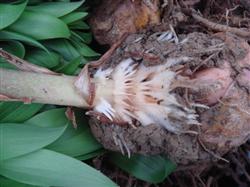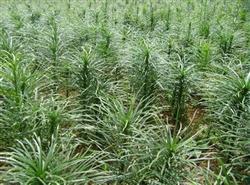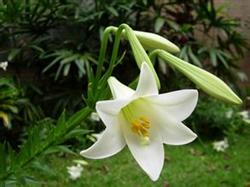Symptoms and control of Rhizoctonia sclerotiorum of lily

If the infection is mild, it only harms the leaves in the soil and the green leaves in the lower part of the buds, with sunken light brown spots on the leaves. Generally speaking, although the growth of the plant is affected, it can continue to grow. If the plant is seriously infected, the growth of the aboveground part will be hindered, and the white leaves in the underground part and the basal leaves in the aboveground part will rot or wilt off, leaving only brown scars on the stem. Young leaves and growth points are often harmed, and infected plants will inhibit rhizome development, which in turn hinders plant growth, resulting in poor flowering or even no flowers, because the flower buds have dried up at an early stage. The pathogen of the disease is eggplant shredded nucleus. Fungi mainly infect plants from the soil and are most active when the temperature is higher than 15 ℃ and humidity. The control method uses soil disinfectant to disinfect the soil that has been suspected to be infected. After disinfection, the soil must be protected from infection, especially when the soil temperature is high in summer. If the previous crop has been infected, general soil disinfectant should not be applied. Before planting, the soil was pre-treated with Rhizoctonia, and it was completely mixed into the soil 10 cm deep.
- Prev

Lily speed should prevent waterlogging for a long time.
The management before emergence from sowing to before and after emergence of lily is mainly to clear the ditch and drainage to ensure that the lily land is neither dry nor waterlogged, there is no low temperature freezing injury, and ensure the normal growth of bulb root system. Seedling stage management is generally in late April or early May this stage, when the seedling height of about 10 cm, the general mu of rotten.
- Next

How to manage Lily during its growing period
Before emergence, the management should do a good job of ditch drainage to ensure that the lily land is neither dry nor waterlogged, and there is no low temperature freezing damage. Seedling management from late April to early May, when the seedling height is about 10 cm, 2550 kg of rotten vegetable cake fertilizer or 30 piculs of rotten pig manure and urine are applied per mu (chemical fertilizer containing fluorine and chlorine can not be applied, let alone without heap.
Related
- Fuxing push coffee new agricultural production and marketing class: lack of small-scale processing plants
- Jujube rice field leisure farm deep ploughing Yilan for five years to create a space for organic food and play
- Nongyu Farm-A trial of organic papaya for brave women with advanced technology
- Four points for attention in the prevention and control of diseases and insect pests of edible fungi
- How to add nutrient solution to Edible Fungi
- Is there any good way to control edible fungus mites?
- Open Inoculation Technology of Edible Fungi
- Is there any clever way to use fertilizer for edible fungus in winter?
- What agents are used to kill the pathogens of edible fungi in the mushroom shed?
- Rapid drying of Edible Fungi

